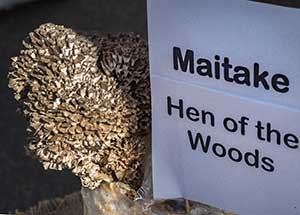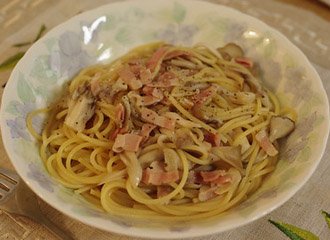Maitake mushroom Nutrition facts
Maitake mushroom or "hen of the woods" is another flavorful, wild fungal fruiting body that mushroom enthusiasts love to forage!. Maitake, recognized as the "king of mushrooms" in Japan where it has long been used as an adaptogenic to treat several ailments, is an important medicinal and culinary mushroom.
Scientific name: Grifola frondosa. Maitake is called as hen-of-the-woods in the English speaking countries. Signorina mushroom, ram's head, hen, Huī shù huā ( 灰树花), etc are some of other popular names of this mushroom.
 |
| Hen of the wood mushrooms. Photo courtesy: USDA. |
Identification
Hen-of-the-woods are one of the largest mushrooms. They are generally found at the base and old decaying stumps of oak trees. While foraging in the woods, maitake can look like a pile of old leaves against a stump from a distance.
Look for overlapping, vivid-brown above and white below caps, which when seen from a distance, appear like ruffled feathers of the back of a hen. The caps feature a smooth rubbery texture that quickly springs back when bent down and then released. Fine pores cover the under-surface of caps. Its multi-branched stalk is white, quite thick and short, and stubby.
G. frondosa is quite similar to the edible Polypore G. umbellata. The caps on G. umbellata are umbrella-shaped and are more open than on G. frondosa. Maitake are also confused to Berkeley's polypore (B. berkeleyi), cauliflowers (Sparassis spp.), etc.
Cultivation
Technically, maitake is a perennial, saprophytic polypore fungus. In the past, maitake has foraged only in the temperate forests of Eastern American states, Siberia, and Japan. Commercial cultivation has now made it possible to produce this mushroom in large quantities so that people around the world can enjoy the benefits of this important mushroom.
Maitake prefers buried hardwood logs and stumps outdoors and supplemented hardwood sawdust indoors. Fruiting is slow and appears after 12-16 months after spawning inoculation in the cultivated farms. To harvest, pull the entire mushroom from the substrate at the base.
8 amazing Health benefits of Maitake mushrooms
Maitake is low in calories; 100 gram of fresh mushroom holds just 31 calories. Nevertheless, this highly prized gourmet mushroom is naturally rich in bioactive compounds, antioxidants, vitamins, and minerals that promote health.
Maitake composes β-glucan, a polysaccharide compound which has cholesterol reducing properties.
Maitake, along with Ling zhi, Coriolus (turkey tail mushroom), is one of the well-recognized medicinal fungi used in the traditional Chinese medicine (TCM) for centuries. It is believed to have immunomodulator, anti-tumor, anti-diabetic, and cholesterol-reducing properties.
Maitake mushrooms are the highest source of vitamin-D (ergo-calciferol) of all the edible fungi; at 1123 IU per 100 g (280% of DA). Vitamin D plays a vital role in bone health, and calcium and phosphate metabolism.
Maitake is one of the richest source of niacin (vitamin-B3). 100 g of this fungi carries 6.585 mg (41% DA). Niacin plays a vital role in fat, and carbohydrate metabolism, and DNA repair.
Fresh maitake carries relatively good amounts of folic acid (21 μg 5% per 100 g).
Maitake also contains sufficient levels of other B-complex group of vitamins like thiamin, riboflavin, pantothenic acid, pyridoxine, etc.
Minerals such as copper (28% DA), iron, zinc, and phosphorus are present in moderate levels in this mushroom.
| Principle | Nutrient Value | Percent of RDA |
|---|---|---|
| Energy | 31 Kcal | 1.5% |
| Carbohydrates | 6.97 g | 5.4% |
| Protein | 1.94 g | 3.5% |
| Total Fat | 0.19 g | 1% |
| Dietary Fiber | 2.7 g | 7% |
| Vitamins | ||
| Folates | 21 μg | 5% |
| Niacin | 6.585 mg | 41% |
| Pantothenic acid | 0.270 mg | 5% |
| Pyridoxine (B-6) | 0.056 mg | 4% |
| Riboflavin | 0.242 mg | 18.6% |
| Thiamin | 0.146 mg | 12% |
| Vitamin-D | 1123 IU | 280% |
| Electrolytes | ||
| Sodium | 1 mg | 1% |
| Potassium | 204 mg | 4% |
| Minerals | ||
| Calcium | 1 mg | <1% |
| Copper | 0.252 mg | 28% |
| Iron | 0.30 mg | 3.75% |
| Magnesium | 10 mg | 2.5% |
| Manganese | 0.059 mg | 2.5% |
| Phosphorus | 74 mg | 10.5% |
| Selenium | 2.2 μg | 4% |
| Zinc | 0.75 mg | 7% |
Selection and storage
Hen-of-the-woods sold as a specialty produce in the supermarkets in closed packs and cans. Fresh maitake can also be found in the farmers' markets during the season. Air-dried maitake and powder in air-seal packs are also sold throughout the year.
It keeps well when placed between 3-6 degrees for many weeks. Dried mushroom sections can be stored for several months and retain their fleshy texture when rehydrated.
Preparation and serving methods
Maitake mushrooms impart earthy, woody flavor to the recipes. Its fleshy, chewy texture goes well in flavorful savory recipes. Dry sections of maitake can b easily reconstituted by soaking them in lukewarm water for 30 minutes. When the rehydrated maitake becomes plump and fleshy, they can be ready to use in the recipes.
Use them along with their soaking water in soups or sauces.
 |
| maitake bacon spaghetti recipe. pelican |
Here are some serving tips:
In mainland China and Japan, maitake consumption is usually driven by their widely accepted immune-boosting and medicinal properties.
Maitake mushroom imparts a special woody flavor when used in chicken and meat dishes.
They can be a great replacement for other foraged mushrooms like oyster, chicken of the woods, etc.
Sauteed maitake slices can be simply enjoyed as a side dish.
Maitake sections complement well in soups and sauces and work well with rice, pasta dishes, eggs, tofu, etc.
Fine sliced maitake can also be tastier in pizza, and potpie preparations.
Dried maitake powder can be added to enhance the flavor of soups and gravies, minced meat dishes.
Safety profile
Handling and consuming maitake mushrooms may elicit hypersensitivity reactions, particularly in some sensitive persons. Inhalation of G. frondosa spores by persons who work indoors in mushroom farms may develop serious allergic alveolitis and mushroom workers lung disease.
Workers in these farms are advised to wear masks to limit spore inhalation and to seek medical help if develop signs and symptoms such as cough, breathing difficulty, rhinitis, etc. (Medical disclaimer).
≻≻-Back to Mushrooms from Maitake mushroom. Visit here for an impressive list of edible mushrooms with complete illustrations of their nutrition facts and health benefits.
≻≻-Back to Home page.
Further reading and Resources:
PubMed.gov- Soluble ß-glucan from Grifola frondosa induces tumor regression in synergy with TLR9 agonist via dendritic cell-mediated immunity.